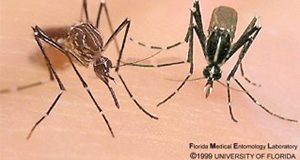
Zika es un virus transmitido por mosquitos que se ha esparcido recientemente en regiones tropicales y ha causado epidemias, especialmente durante los últimos 8 o 9 años. En su ámbito nativo en África Occidental y Uganda, el virus se mantiene en los bosques, circulando entre mosquitos que viven en huecos de árboles y primates arbóreos; las infecciones de humanos se consideran incidentales y de poca importancia médica. Una cepa del virus que se implicó en brotes en Polinesia Francesa emergió en el Norte de Brasil en el 2015 y causó gran consternación debido a la alta incidencia de microcefalia en bebes nacidos de madres que fueron infectadas con el virus durante la gestación. Transmisión local, principalmente por el mosquito de la fiebre amarilla Aedes aegypti, ha sido documentada en la mayoría de los países tropicales de las Américas, pero aún no se ha detectado en Los Estados Unidos Continentales. Los síntomas de la infección incluyen, salpullido, dolor de cabeza, fiebre, dolor muscular y en las coyunturas, conjuntivitis, y malestar general.
This 7-page fact sheet written by J. R. Rey, L. P. Lounibos, B. W. Alto, N. D. Burkett-Cadena, C. C. Lord, C. T. Smartt, and C. R. Connelly and published by the Department of Entomology and Nematology is the Spanish language version of Zika, a Mosquito-Transmitted Virus and describes the Zika microbe, its mosquito hosts, and the disease it causes. A history of the virus and its migration are included, along with some details about the virus in the state of Florida and preventative measures people can take to avoid infection. The best way to avoid contracting Zika (and other mosquito-borne diseases) is not to get bitten in the first place. Take precautions to avoid mosquito bites.
http://edis.ifas.ufl.edu/in1121

